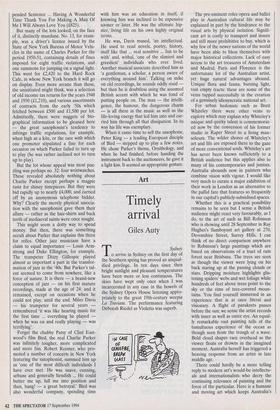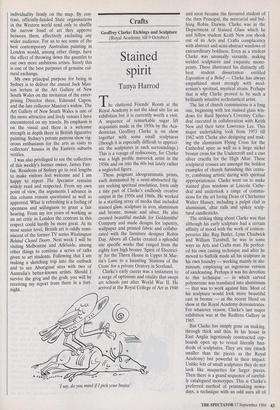Art
Timely arrival
Giles Auty
TSydney o arrive in Sydney on the first day of the Southern spring has proved an unqual- ified privilege. In ten days since then bright sunlight and pleasant temperatures have been more or less continuous. The skies have wept only once when I was incarcerated in any case in the bowels of the Sydney Opera House listening appro- priately to the great 19th-century weepie La Traviata. The performance featuring Deborah Riedel as Violetta was superb. The pre-eminent roles opera and ballet play in Australian cultural life may be explained in part by the hindrance to the visual arts by physical isolation. Signifi- cant art is costly to transport and insure and still more prohibitive to buy, which is why few of the newer nations of the world have been able to bless themselves with major historical collections. Lack of easy access to the art treasures of Amsterdam and Madrid, Paris and Florence is the unfortunate lot of the Australian artist, yet huge natural advantages abound. Unique flora and fauna, burning light, vast empty tracts: these are some of the veins tapped successfully in the creation of a genuinely idiosyncratic national art.
For urban hedonists such as Brett Whiteley there were other veins to explore which may explain why Whiteley's unique and quirky talent is commemorat- ed now by the conversion of his former studio in Raper Street to a living mau- soleum. The wilder shores of Whiteley's art and life are exposed there to the gaze of more conventional souls. Whiteley's art has never been known sufficiently to a British audience but this applies also to many of his contemporaries and juniors. Australia abounds now in painters who combine vision with vigour. I would like very much to curate a major exhibition of their work in London as an alternative to the pallid fare that features so frequently in our capital's publicly-subsidised spaces.
Whether this is a practical possibility remains to be seen but I sense a British audience might react very favourably, as I do, to the art of such as Bill Robinson who is showing until 28 September in Ray Hughes's flamboyant art gallery at 270, Devonshire Street, Surrey Hills. I can think of no direct comparison anywhere to Robinson's large paintings which are based on observations of a tract of rain forest near Brisbane. The trees are seen as though the viewer were lying on his back staring up at the passing clouds or stars. Dripping moisture highlights glis- tening spiders' webs and wet foliage while hundreds of feet above trees point to the sky or the rims of tree-covered moun- tains. You find yourself immersed in an experience that is at once literal and visionary. A flight of parakeets passes before the sun; we sense the artist records with inner as well as outer eye. An equal- ly remarkable vast painting tells of the tumultuous experience of the ocean as though seen from the trough of a wave. Bold cloud shapes race overhead as the viewer floats or drowns in the imagined moment. Australia herself has triggered a heaving response from an artist in late middle age.
There could hardly be a more telling reply to modern art's would-be intellectu- als and internationalists who decry the continuing relevance of painting and the force of the particular. Here is a humane and moving art which keeps Australia's individuality firmly on the map. By con- trast, officially-funded State organisations in the Western world tend only to shuffle the narrow band of art they approve between them, effectively excluding any wider audience. For us to see some of the best contemporary Australian painting in London would, among other things, have the effect of throwing down the gauntlet to our own more ambitious artists. Surely this is one of the best purposes of genuine cul- tural exchange.
My own principal purpose for being in Sydney is to deliver the annual Jack Man- ton lecture at the Art Gallery of New South Wales on the invitation of the enter- prising Director there, Edmund Capon, and the late collector Manton's widow. The Art Gallery of New South Wales is one of the more attractive and lively venues I have encountered on my travels. Its emphasis is on the visual and there is a welcome strength in depth there in British figurative painting. Sydney's private patrons show vig- orous enthusiasm for the arts as visits to collectors' houses in the Eastern suburbs verifies.
I was also privileged to see the collection of this weekly's former owner, James Fair- fax. Residents of Sydney go to real lengths to make visitors feel welcome and I am happy to report The Spectator remains widely read and respected. From my own point of view, the arguments I advance in this column remain questioned as well as approved. What is refreshing is a feeling of openness and willingness to grant a fair hearing. From my ten years of working as an art critic in London the contrast in this respect could hardly be more great. At its most senior level, British art is oddly remi- niscent of the former TV series Washington Behind Closed Doors. Next week I will be visiting Melbourne and Adelaide, among other things to continue a series of talks given to art students. Following that I am making a sketching trip into the outback and to see Aboriginal sites with two of Australia's better-known artists. Should I survive the grog and the grub, you will be receiving my report from there in a fort- night.



























































 Previous page
Previous page